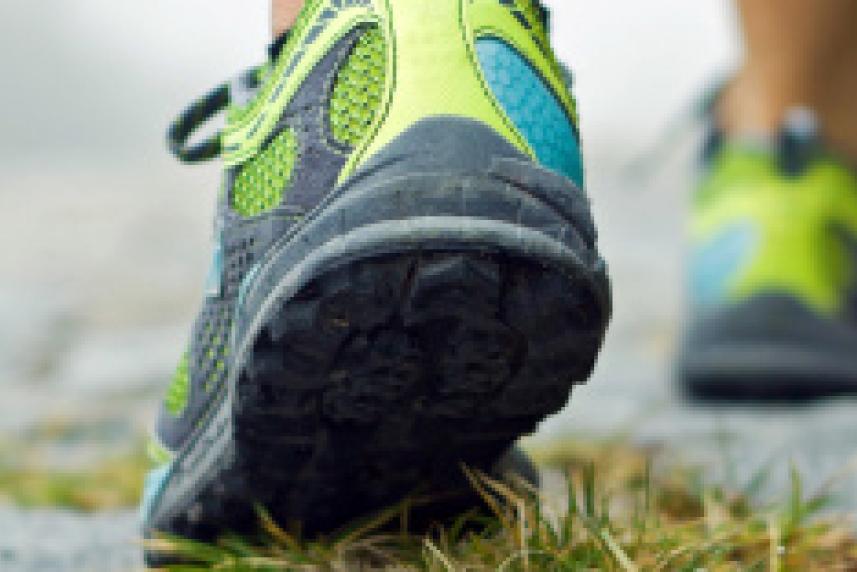Four steps to finding the right workout shoes
For fitness success and healthy feet, make sure the shoe fits.

The right shoes will not only make your workouts more effective, they'll make your body feel better. To make sure you purchase the best shoes for your feet, follow these guidelines from Judith Baumhauer, MD, professor and associate chair of orthopaedics at the University of Rochester Medical Center and a past president of the American Orthopaedic Foot and Ankle Society.
Step 1: Know Your Foot Structure
It's important to know your foot structure so that you find the most supportive shoe for you and avoid injury, Dr. Baumhauer says. The huge number of athletic shoe options available is both a blessing and a curse—each shoe is tailored to a specific foot type, but you have to find the right one for your feet to ensure you don't injure yourself with repeated wear. Standard foot measurements you need to consider are size and arch shape.
Check Your Size:
Your sneaker should be no more than a half-inch longer or wider than your naked foot. To check if your current sneaker is the right size, Dr. Baumhauer recommends standing on a piece of paper and tracing your foot with a pen. Compare your foot tracing against your sneaker and see how much room there is. There should be a half-inch of room above your toes and a half-inch space from the outside edge of your foot. Both tight and loose shoes can cause painful blisters and calluses, not to mention they can undo the support offered by a well-constructed shoe.
Measure Your Arch Shape:
To figure out your arch shape, wet your feet and walk across a floor that will show your footprints (or step on a piece of paper). If you can see your whole footprint, you have a "flat foot." A very narrow footprint with just the outside edge of the print visible denotes "high arch." A print with about half the foot visible indicates a "normal arch." If you have normal or high arches, look for sneakers with arch support or use an over-the-counter insert. If you’re flat-footed, you don't need a shoe that advertises arch support.
Step 2: Know Your Foot Motion
Everyone moves with a different foot fall. The most common are neutral, overpronation, and supination. Overpronators naturally rotate their ankle outwards when they step, while supinators rotate their foot inwards when they step, both of which can cause injury to your feet and ankle with repeated stress, like when you’re exercising. A neutral foot fall means your foot naturally rolls inward as you step forward, but not to the extent of overpronation. Next time you walk, pay attention and see how your feet and ankles move.
If you're unsure if you pronate or supinate, head to a running store or podiatrist and have someone watch as you jog. It's important to support your gait properly, as prolonged exercise if you're overpronating or supinating can damage the foot and ankle. You can purchase shoes with motion control to support your foot and keep your step neutral. Look for a shoe with a stiff heel counter, the part of the shoe that keeps your heel in place. The heel counter wraps around the side and back of your heel to help support your gait.
Step 3: Know Your Accessories
When you exercise, you sweat. Socks made of fabric that retain moisture, like cotton, will rub up against your feet, which can cause blisters and calluses. Instead, look for socks made from synthetic wicking fabric that's specially made for athletic wear.
How you lace your shoes can also affect your comfort level. "If you have a high arch and a prominent mid-foot, too-tight laces can irritate the 'dorsal bossing.' It will be like someone is stepping on top of your laces,” Dr. Baumhauer says. (Dorsal bossing refers to the bony part on the top of your foot.) To avoid pressure, try tying your shoes like this: Do a regular criss-crossing lace from the bottom, stopping before the bony part of your foot. Then string each lace between the eyes on the same side, to create a hole across the tongue. Continue to lace in a criss-cross above the gap.
Step 4: Look for The Best Shoe for Your Workout
The good news for your wallet is that a good athletic shoe with the proper support for running will also be good for walking, indoor cardio, and group exercise classes.
After you've sifted through the seemingly endless options for athletic sneakers and chosen a shoe for you, slowly break them in, especially if you're new to exercise. Even if you have the best possible pair of shoes, going from zero to five days a week of exercise can injure your feet.
"You wouldn't run a marathon the first day you started running. The bones in your foot need to adapt to stress," Dr. Baumhauer says. If your feet are used to exercise, it's still important to slowly break in your new shoes. Try alternating between your old and new shoes every other workout for two weeks when making the transition. A healthy foot in the proper shoe shouldn't be experiencing pain, she says.
Ultimately, one of the best judges of the right sneaker is the person who's wearing it. "If that shoe feels good and if you feel comfortable in it, it's probably a good one for you. You shouldn't have to mold to your shoe, your shoe should fit to you," Dr. Baumhauer says.
Talk to your doctor before beginning a new exercise program.


